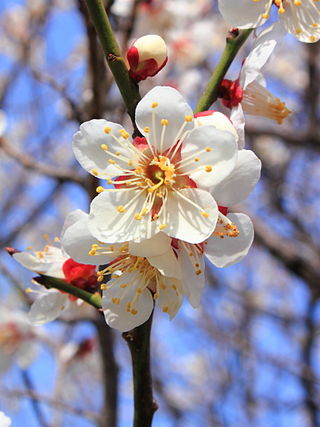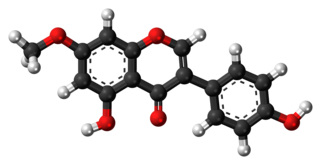
A cherry is the fruit of many plants of the genus Prunus, and is a fleshy drupe.

An apricot is a fruit, or the tree that bears the fruit, of several species in the genus Prunus.

A plum is a fruit of some species in Prunus subg. Prunus. Dried plums are most often called prunes, though after the year 2000 in the United States they may be just labeled as 'dried plums'.

Prunus is a genus of trees and shrubs, which includes the fruits plums, cherries, peaches, nectarines, apricots, and almonds.

Flavonoids are a class of polyphenolic secondary metabolites found in plants, and thus commonly consumed in the diets of humans.

A cherry blossom, also known as Japanese cherry or sakura, is a flower of many trees of genus Prunus or Prunus subg. Cerasus. They are common species in East Asia, including China, Korea and especially in Japan. They generally refer to ornamental cherry trees, not to be confused with cherry trees that produce fruit for eating. It is considered the national flower of Japan.

Prunus mume is a Chinese tree species classified in the Armeniaca section of the genus Prunus subgenus Prunus. Its common names include Chinese plum,Japanese plum, and Japanese apricot. The flower, long a beloved subject in the traditional painting and poetry of Sinospheric countries, is usually called plum blossom. This distinct tree species is related to both the plum and apricot trees. Although generally referred to as a plum in English, it is more closely related to the apricot. In East Asian cuisine, the fruit of the tree is used in juices, as a flavouring for alcohol, as a pickle, and in sauces. It is also used in traditional medicine.

Quercetin is a plant flavonol from the flavonoid group of polyphenols. It is found in many fruits, vegetables, leaves, seeds, and grains; capers, red onions, and kale are common foods containing appreciable amounts of it. It has a bitter flavor and is used as an ingredient in dietary supplements, beverages, and foods.

Prunus serotina, commonly called black cherry, wild black cherry, rum cherry, or mountain black cherry, is a deciduous tree or shrub of the genus Prunus. Despite being called black cherry, it is not very closely related to the commonly cultivated cherries such as sweet cherry, sour cherry and Japanese flowering cherries which belong to Prunus subg. Cerasus. Instead, P. serotina belongs to Prunus subg. Padus, a subgenus also including Eurasian bird cherry and chokecherry. The species is widespread and common in North America and South America.

Naringenin is a flavorless, colorless flavanone, a type of flavonoid. It is the predominant flavanone in grapefruit, and is found in a variety of fruits and herbs.
In enzymology, a flavonoid 3'-monooxygenase (EC 1.14.14.82, was wrongly classified as EC 1.14.13.21 in the past) is an enzyme that catalyzes the chemical reaction

Techtochrysin is a chemical compound. It is an O-methylated flavone, a flavonoid isolated from Prunus cerasus, the sour cherry, a plant native to much of Europe and southwest Asia.

Taxifolin (5,7,3',4'-flavan-on-ol), also known as dihydroquercetin, belongs to the subclass flavanonols in the flavonoids, which in turn is a class of polyphenols.

Dihydrokaempferide is a flavanonol, a type of flavonoid. It can be found in Prunus domestica, in the wood of Salix caprea and in the Brazilian green propolis.
The O-methylated flavonoids or methoxyflavonoids are flavonoids with methylations on hydroxyl groups. O-methylation has an effect on the solubility of flavonoids.

Afzelechin is a flavan-3-ol, a type of flavonoid. It can be found in Bergenia ligulata. It exists as at least 2 major epimers.

Prunetin is an O-methylated isoflavone, a type of flavonoid. It has been isolated for the first time by Finnemore in 1910 in the bark of Prunus emarginata. Prunetin isolated from pea roots can act as an attractant for Aphanomyces euteiches zoospores. It is also an allosteric inhibitor of human liver aldehyde dehydrogenase.

Prunus avium, commonly called wild cherry, sweet cherry, gean, or bird cherry is a species of cherry, a flowering plant in the rose family, Rosaceae. It is native to Europe, Anatolia, Maghreb, and Western Asia, from the British Isles south to Morocco and Tunisia, north to the Trondheimsfjord region in Norway and east to the Caucasus and northern Iran, with a small isolated population in the western Himalaya. The species is widely cultivated in other regions and has become naturalized in North America and Australia.

Prunus nipponica, also called Japanese alpine cherry, is a shrub which originates from the islands of Hokkaido and Honshu, Japan. It grows to a height of about 5 meters (16 ft) and can grow in sandy, loamy, and clay soils.

Prunus leveilleana is a native of Korea and Japan. It generally has autumnal leaves of reddish-brown or crimson red colour. It has flowers of bright yellow-white colors.


















